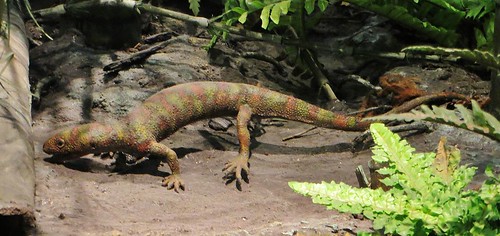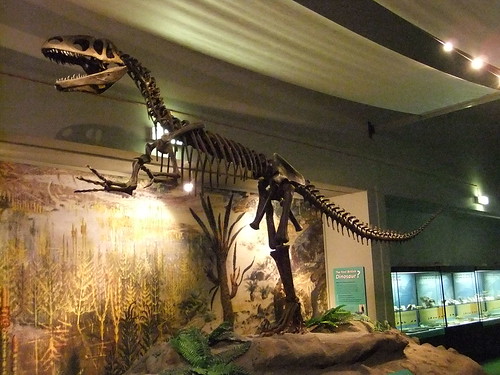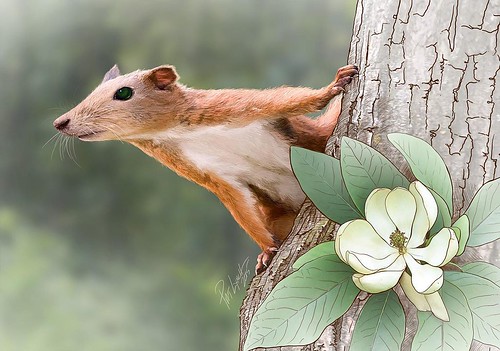-
4.560 Billion Years Ago
 The planet Earth forms from the protoplanetary disk of dust grains and rocks attracting by the force of gravity at the outer edge of the habitable zone in the accretion disc revolving around the young Sun
The planet Earth forms from the protoplanetary disk of dust grains and rocks attracting by the force of gravity at the outer edge of the habitable zone in the accretion disc revolving around the young Sun -
4.533 Billion Years AgoPlanet Earth and the hypothesized protoplanet Theia collide sending large number of moonlets into orbit around the Earth which eventually coalesce to form the Moon
-
3.6 Billion Years Ago
 Prokaryotes, the first simple cells without nucleus and mitochondria, that use carbon dioxide as a carbon source and oxidize inorganic materials to extract energy, appear, probably in deep-sea thermal vents or atmosphere
Prokaryotes, the first simple cells without nucleus and mitochondria, that use carbon dioxide as a carbon source and oxidize inorganic materials to extract energy, appear, probably in deep-sea thermal vents or atmosphere -
2.9 Billion Years Ago
 Photosynthesizing cyanobacteria, which use water and carbon dioxide as a reducing agent and produce oxygen as waste product, evolve, creating the oxygen-rich atmosphere
Photosynthesizing cyanobacteria, which use water and carbon dioxide as a reducing agent and produce oxygen as waste product, evolve, creating the oxygen-rich atmosphere -
2.1 Billion Years Ago
 Eukaryotes, complex cells which contain nucleus enclosed within membranes, derive from prokaryotes via fusion of some cells and free-living bacteria, which become mitochondria and start providing energy to the cell by converting sugars
Eukaryotes, complex cells which contain nucleus enclosed within membranes, derive from prokaryotes via fusion of some cells and free-living bacteria, which become mitochondria and start providing energy to the cell by converting sugars -
1.2 Billion Years Ago
 First simple multicellular organisms, mostly consisting of cell colonies of limited complexity, evolve independently in some groups of single cells, which allows organisms to exceed the size limits
First simple multicellular organisms, mostly consisting of cell colonies of limited complexity, evolve independently in some groups of single cells, which allows organisms to exceed the size limits -
580 Million Years AgoThe accumulation of atmospheric oxygen allows the formation of an ozone layer, which blocks ultraviolet radiation, permitting the colonisation of the land
-
540 Million Years Ago
 The Cambrian explosion, the relatively rapid, lasting 70 million years, appearance of most major animal phyla accompanied by major diversification of organisms, begins
The Cambrian explosion, the relatively rapid, lasting 70 million years, appearance of most major animal phyla accompanied by major diversification of organisms, begins -
435 Millions Years Ago
 The first primitive plants move onto land and rapidly diversify, having evolved from green algae living along the edges of lakes
The first primitive plants move onto land and rapidly diversify, having evolved from green algae living along the edges of lakes -
365 Million Years Ago
 First amphibians, four-limbed backboned tetrapods, evolve from the lobe-finned fishes, gradually gaining adaptations, such as lungs and nares, which will help them occupy land and give rise to reptiles and mammals
First amphibians, four-limbed backboned tetrapods, evolve from the lobe-finned fishes, gradually gaining adaptations, such as lungs and nares, which will help them occupy land and give rise to reptiles and mammals -
320 Million Years Ago
 The first reptiles evolve from advanced reptiliomorph labyrinthodonts, a newt-like amphibians that gain scaly skin and begin laying eggs with hard shells outside the water
The first reptiles evolve from advanced reptiliomorph labyrinthodonts, a newt-like amphibians that gain scaly skin and begin laying eggs with hard shells outside the water -
220 Millions Years Ago
 Adelobasileus, the first known mammal, which resembles modern rats and has sweat glands, including those that are specialized to produce milk to nourish their young, evolves from reptiles called cynodonts
Adelobasileus, the first known mammal, which resembles modern rats and has sweat glands, including those that are specialized to produce milk to nourish their young, evolves from reptiles called cynodonts -
200 Million Years AgoPangaea, the large supercontinent, begins to rift into two continents: Laurasia, which contains North America and Eurasia, and other supercontinent - Gondwana, containing Africa, South America, India, Antarctica, and Australia
-
199,6 Million Years Ago
 Triassic-Jurassic extinction event wipes out twenty percent of all marine families and all large non-dinosaurian archosaurs other than crocodilians on land, leaving the dinosaurs the dominant land animals
Triassic-Jurassic extinction event wipes out twenty percent of all marine families and all large non-dinosaurian archosaurs other than crocodilians on land, leaving the dinosaurs the dominant land animals -
155 Million Years Ago
 Archaeopteryx, one of the first birds and transitional fossil between feathered dinosaurs and modern birds, appears following evolution of some other early birds, such as Anchiornis and Aurornis
Archaeopteryx, one of the first birds and transitional fossil between feathered dinosaurs and modern birds, appears following evolution of some other early birds, such as Anchiornis and Aurornis -
130 Million Years Ago
 The first flowering plants, whose boast structures attract insects and other animals to spread pollen, which causes a major burst of animal evolution through co-evolution, appear
The first flowering plants, whose boast structures attract insects and other animals to spread pollen, which causes a major burst of animal evolution through co-evolution, appear -
65.5 Million Years Ago
 An asteroid 10 kilometers in diameter falls on the coast of Yucatán in Mexico and causes the Cretaceous–Paleogene extinction event with eradicating about half of all animal species, including the dinosaurs but excluding their descendants, the birds
An asteroid 10 kilometers in diameter falls on the coast of Yucatán in Mexico and causes the Cretaceous–Paleogene extinction event with eradicating about half of all animal species, including the dinosaurs but excluding their descendants, the birds -
65 Million Years Ago
 Purgatorius, a rat-sized placental mammal with mass about 40 grams, becomes the earliest example of a primate or a proto-primate, giving rise to monkeys, apes and humans
Purgatorius, a rat-sized placental mammal with mass about 40 grams, becomes the earliest example of a primate or a proto-primate, giving rise to monkeys, apes and humans -
2.5 Million Years Ago
 Homo habilis, the earliest known species of the genus Homo, evolves from Hominidae in East Africa, beginning usage of primitive stone tools for hunting and work
Homo habilis, the earliest known species of the genus Homo, evolves from Hominidae in East Africa, beginning usage of primitive stone tools for hunting and work -
200 Thousand Years Ago
 Anatomically modern human, who has more gracile frames, reduced brow ridges and vertical forehead, evolve from archaic Homo sapiens in East Africa
Anatomically modern human, who has more gracile frames, reduced brow ridges and vertical forehead, evolve from archaic Homo sapiens in East Africa
Monday, May 8, 2017
20 Most Important Events in Earth's History
Labels:
Archean,
Catastrophes,
Cells,
Eclipses,
Evolution,
Geology,
Hadean,
Kaapvaal Craton,
Mesoarchean,
Moon,
Paleoarchean,
Pilbara Craton,
Planets,
Precambrian,
Prokaryotes,
Solar Eclipses,
Supercontinents,
Theia,
Vaalbara
Subscribe to:
Comments (Atom)